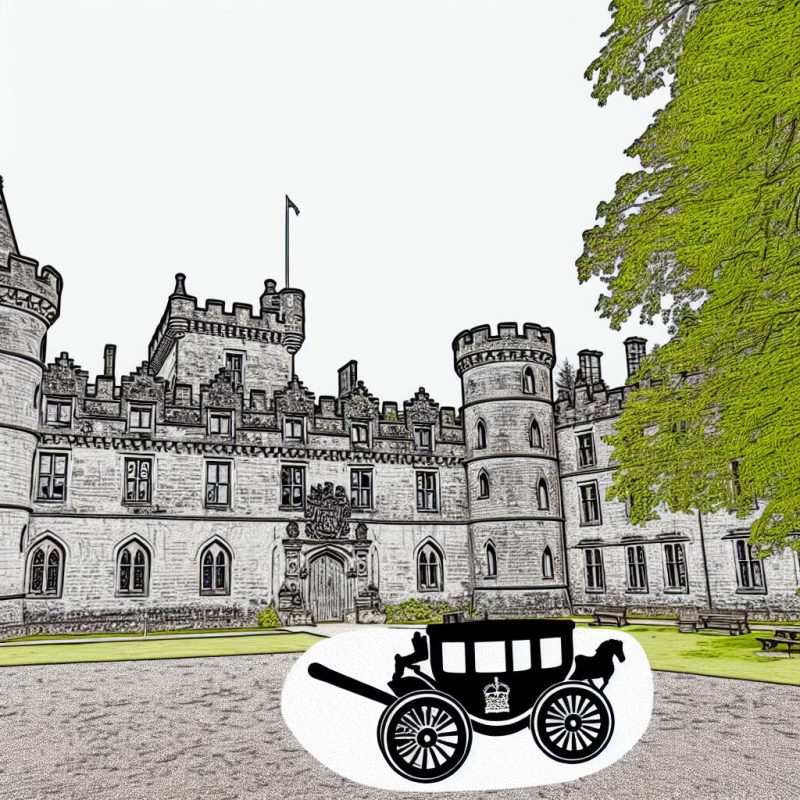Inveraray Castle: A Reflection of Scottish Heritage
Inveraray Castle is a renowned landmark in Scotland, located on the banks of the beautiful and expansive Loch Fyne in the region of Argyll. Known for its stunning architecture and historical significance, Inveraray Castle has served as an emblem of Scottish nobility and cultural heritage for centuries. Today, it continues to be the ancestral home of the Duke of Argyll, the head of the mighty Campbell Clan, which is one of the most powerful and influential clans in Scottish history.
Architectural Marvel and Design
Constructed during the late 18th century, Inveraray Castle stands as a remarkable example of Gothic Revival architecture. This architectural style is characterized by its unique ornamental features and intricate designs. The castle is known for its distinct conical spires and turreted towers, features that are attributed to the creativity and vision of architects Roger Morris and William Adam. Over the years, Inveraray Castle has undergone significant modifications, reflecting not only aesthetic evolution but also the changing architectural preferences and functional needs of its inhabitants.
The design of the castle harmoniously connects the historical with the practical, ensuring that while it maintains its decorative allure, it also keeps up with modern-day living expectations. The balance of these elements demonstrates the architectural foresight of its designers, making Inveraray Castle an exceptional study in sustainable grandeur.
The Interior of Inveraray Castle
When venturing inside Inveraray Castle, visitors can explore a magnificent collection of artifacts and artworks that depict the rich history of the region and its people. Among the notable features inside the castle is the extensive armory hall, which contains a vast collection of weaponry dating back through Scotland’s storied past. The armory provides insights into the military history and defensive strategies utilized by the Campbell Clan and their ancestors.
Further into the castle, several opulent state rooms await, each adorned with fine tapestries and exquisite period furnishings. These rooms not only serve as a testament to the artistic excellence of the periods they represent but also offer a glimpse into the lifestyle of Scottish aristocracy. Engaging with these spaces allows visitors to immerse themselves in the rich history, artistic achievements, and the enduring cultural heritage maintained by the aristocratic Campbell family.
The Gardens and Grounds
Spanning over 60,000 acres, the gardens and grounds of Inveraray Castle are as much a spectacle as the castle itself, offering picturesque landscapes and serene environments for exploration. The estate encompasses meticulously maintained formal gardens, vast woodlands, and a series of scenic walking trails that weave through the natural beauty surrounding the castle. These gardens, with their diverse array of plant species and carefully arranged landscaping, provide a tranquil escape for visitors seeking to connect with nature.
The grounds reflect a commitment to preserving the ecological diversity and historical integrity of the estate, highlighting the importance of balancing heritage conservation with environmental stewardship. Visitors exploring the grounds can enjoy leisurely walks while taking in the views, each step offering a moment of peace and reflection.
Royal Connections and Historical Significance
Inveraray Castle holds significant historical ties with the British royal family and occupies a revered place in Scottish history. For many years, the castle has served as a residence for members of the royal family during their visits to Scotland. Of historical note is the visit by Queen Victoria and Prince Albert in the 19th century, marking an event that included grand celebrations and the planting of a tree by Queen Victoria herself—a gesture of appreciation and connection with the revered Scottish landscape.
Royal Visits and Events
Throughout its history, Inveraray Castle has played host to numerous high-profile royal events and personalities. It served as a shooting lodge during royal hunts, and as a venue for gatherings attended by dignitaries and royalty. Such occasions underscore the castle’s role as a central hub for social and political activity in Scotland, representing both hospitality and strategic importance.
The involvement of the royal family and the hosting of prestigious events at Inveraray Castle have also helped strengthen diplomatic ties between Scotland and the rest of the United Kingdom, fostering goodwill and partnership.
Historical Events and Influence
Inveraray Castle stands as a silent witness to various pivotal moments in Scotland’s history. It has endured through turbulent periods, such as the Jacobite risings, maintaining its place as a symbol of stability and power for the Campbell Clan. The strategic location of Inveraray Castle, along with its robust construction, made it a critical stronghold during historical conflicts, reinforcing its importance in the defense and governance of the region.
The castle’s influence extends beyond military and political arenas, encompassing cultural and social dimensions as well. It has served as a catalyst for architectural innovation and a beacon of Scottish heritage, offering insights not only into the history of the Campbell Clan but also into the broader historical narrative of Scotland.
Further Exploration
Interest in exploring more about Inveraray Castle can be served through numerous resources and visiting opportunities that are available to the public. The castle’s official website offers a wealth of information regarding tours, events, and ongoing preservation efforts, drawing history enthusiasts and travelers alike. To learn more about visiting and engaging with this unique landmark, including details on special exhibitions and visitor experiences, you can visit Inveraray Castle’s official website.
By offering such comprehensive resources and experiences, Inveraray Castle not only educates its visitors about the past but also connects them to the living heritage of Scotland, allowing for a deeper appreciation and understanding of the cultural aspects that continue to define the nation.

